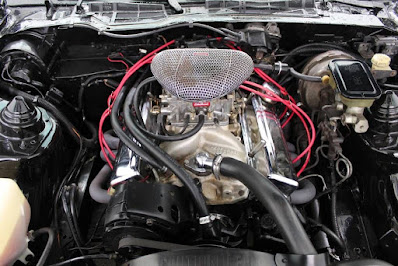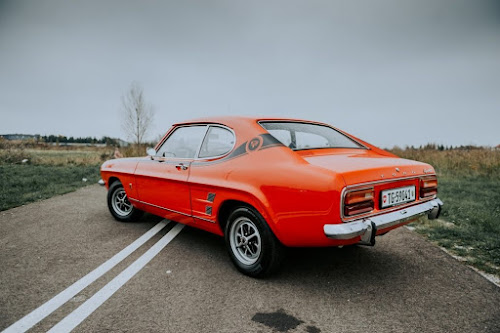
After I was cut off abruptly on I-480 south west of Cleveland a couple of years ago, save for oh-so-short jaunts around town, I hadn't really driven our lovely 1977 "Little Red Corvette" much. That incident frightened me pretty good because when I slammed the brakes to avoid hitting that yahoo, the whole car rotated on its tires with the passenger side rear end swinging around fixing to change places with the passenger front. I knew there was something up "back there" all along but how wrong things were was a mystery. I figured the thumping and clunking was all part of the C3 experience. Well, the moaning, groaning and creaking from the rear end kept getting worse and worse and it finally got so bad that I stopped driving it completely and even dropped insurance coverage. I know. Risky. But that's what can happen with old cars - you love them and would never think of getting rid of them, well, I mean you would but not at a complete loss, but they become too dangerous and a burden to drive.

This past spring I finally decided to do something about it. Armed with years of research on third generation or "C3" Corvette rear suspensions, I dove into the abyss of extreme DIY automobile repair. Am I a mechanic? Nope. Do I really know what I'm doing? Technically, no. Do I have the funds to have this done professionally? Well, yeah, but I don't think it financially responsible to spend the amount of money it would take to have it done professionally. That amount, when all said and done, being more than the car was worth. Especially in the dilapidated condition the car was in. And, being honest, I enjoy working on cars. So, with these dis-parent notions I got down and dirty.

While gorgeous, rolling works of art, second and third generation Corvette's come with a number of inherent problems. Their fiberglass bodies flex and can crack and are very expensive to repair. Their cast iron frames are rust prone, they have myriad electrical issues as well. However, it's their independent rear suspensions that are perhaps their most overlooked problem areas. They're Fred Flinstone mobile primitive, wear out easily and, being totally honest, don't really provide a degree of performance improvement above and beyond sporty domestic cars of similar vintage with "live", rigid rear axles. Worse yet, they can be frighteningly expensive to repair. Even if you do the repairs yourself.

Diagnosing problems with cars, old and newer, is often times more challenging than the repair work itself. However, with our Corvette, it was pretty easy to determine that the issue with the rear end was that the bushings on the trailing arms were worn out. Also, the metal shims that brace the trailing arms against the body inside pockets on the frame were shot as well. Yes, metal shims that brace the arms in pockets on the frame; I said these things were primitive. I deduced from my research that "all I had to do" was pull the trailing arms, replace the bushings and shims, put everything back together, align it and very affordably rock and roll. I'd upgrade the tires too since I found, and embarrassingly so, they're over thirty years old.

Dismantling the car wasn't complicated but it was physically challenging and fairly dangerous; you never know what could snap a finger or hand off and I really don't like crawling under a car that has nothing more than a pair of thirty-nine dollar Autozone jack stands propping it up. As far as physically demanding, drilling out the rivets that held the brake rotors on felt like the a physical education test administered by the gym teacher from hell. Each one taking upwards of a half an hour of grueling pressing to get out. All in we're talking about five hours of drilling over the better part of a week. That and more than hundred bucks spent on cobalt drill bits. Like I said, this repair work is not cheap.

The real scope of the project took shape once I got the rotors off. I found that the emergency brake hardware on each side was completely rusted up and useless and the cost of replacement hardware pushed my budget into the "replace the trailing arms" territory. Then I found it appeared the wheel bearing on the passenger side had significant play in it. Well, there went just replacing the bushings and shims. Might as well replace the both trailing arms.

If drilling out the rotors was hard, cutting the bolts that held the trailing arms into the pockets in the frame amounted to torture. With the shims rusted to the outboard wall of the pockets and the bushings themselves having come out of the trailing arms, I had no way to determine where the bolts where; I had to start cutting what I could see of the rubber bushings all but completely blind. And with a very limited amount of room inside the pocket, my carbide reciprocating saw blade hit the back of the pocket constantly making it seem as though the worst dental procedure I ever had felt like I was receiving a communion host.
Much like DIY home renovation projects, you never know what you're really getting yourself into until you're knee deep in it. This project got significantly more complicated when I found the transverse leaf spring and the differential needed to be replaced as well. Those two things not only adding significant expense and complication to the whole project but pushing the completion of it towards the end of the year if not into 2021.
Funny, I thought I could do most of this project during a week's furlough from work due to The Pandemic. Funny indeed. Going on sixteen weeks into the project I feel as though I've only just started on it.













































